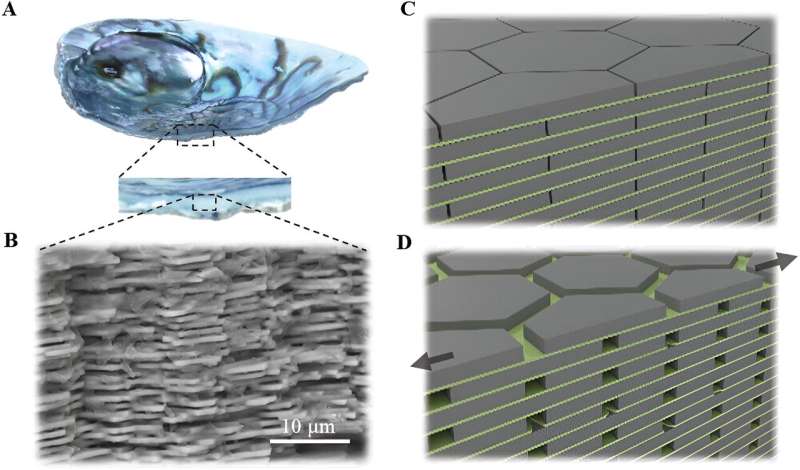
Inspired by the material that makes up oyster and abalone shells, engineers at Princeton have created a new cement composite that is 17 times more crack-resistant than standard cement and 19 times more able to stretch and deform without breaking. The findings could eventually help increase the crack resistance of a wide range of brittle ceramic materials, from concrete to porcelain.
"If we can engineer concrete to resist crack propagation, we can make it tougher, safer and more durable," said researcher Shashank Gupta, a graduate student in Reza Moini's lab in the Department of Civil and Environmental Engineering.
In an article published in Advanced Functional Materials, the research team led by Moini, an assistant professor of civil and environmental engineering, reported that creating alternating layers of tabulated cement paste and thin polymer can significantly increase crack resistance and the ability to deform without completely breaking (ductility).
Moini's lab often looks to biology for inspiration in its work on building materials. In this case, the team developed a composite inspired by a natural material called nacre, or mother of pearl, which is found inside certain shells. Gupta said that at the microscopic level, nacre consists of hexagonal tablets of the hard mineral aragonite glued together by a soft biopolymer.
The aragonite tablets contribute significantly to nacre's strength, while the biopolymer adds flexibility and crack resistance. The toughening mechanism involves the aragonite tablets sliding under stress, which—along with other mechanisms—allows the nacre to dissipate energy. This sliding action, combined with the crack deflection and biopolymer deformation, enables nacre to endure substantial mechanical stress while maintaining its structural integrity, making it both strong and resilient.
"This synergy between the hard and soft components is crucial to nacre's remarkable mechanical properties," Gupta said.
The Princeton team has developed innovative composites inspired by nacre, utilizing conventional construction materials like Portland cement paste combined with a limited amount of polymer. They alternated layers of cement paste sheets with a highly stretchable polymer, polyvinyl siloxane. The researchers created multi-layered small beams by alternating cement paste sheets with thin layers of polymer. These beams were then subjected to a notched three-point bending test, where each beam was tested under flexure to evaluate crack resistance (or fracture toughness).
In the experiment, the researchers produced three types of beams. The first type consisted of alternating layers of cement paste sheets and thin polymer. For the second type, they used a laser to engrave hexagonal grooves into the cement paste sheets. These grooved sheets were then stacked with thin polymer layers in between.
The third type was similar to the second, but the researchers cut through the cement completely, creating separated hexagonal tablets connected by the polymer layer. These cement-paste tablets lay atop the polymer layer similarly to how aragonite lies on the biopolymer layer in nacre. These three types were compared against a reference solid (monolithic) cast cement paste counterpart.
More information: Shashank Gupta et al, Tough and Ductile Architected Nacre‐Like Cementitious Composites, Advanced Functional Materials (2024). DOI: 10.1002/adfm.202313516
Citation: From seashells to cement, nature inspires tougher building material (2024, June 11) retrieved 11 June 2024 from https://techxplore.com/news/2024-06-seashells-cement-nature-tougher-material.html
This document is subject to copyright. Apart from any fair dealing for the purpose of private study or research, no part may be reproduced without the written permission. The content is provided for information purposes only.
